
Photo from wikipedia
SUMMARY The cumulated effects of domestication and subsequent selection by humans have led to impressive diversification of the chicken at the phenotypic as well as the genome level. In theory,… Click to show full abstract
SUMMARY The cumulated effects of domestication and subsequent selection by humans have led to impressive diversification of the chicken at the phenotypic as well as the genome level. In theory, selection may reach a plateau when all favourable alleles have reached fixation. Yet, current data for poultry show that the selection response can still take place after 50 generations or more. The mechanisms maintaining selection response in closed populations may involve recombination, mutation and epistatic interactions. Furthermore, the continuous addition of new selection criteria can delay the possible limits associated to single trait selection. Selection response is mainly threatened by inbreeding, which occurs as a consequence of a narrow genetic base and/or a poor management of variability within the population. Biological limits are encountered when selection degrades fitness traits to a point that the survival of individuals is affected. Biological limits induced by extreme performance can be by-passed by adapting the breeding programme, introducing new selection criteria, changing the management or developing remedial technologies. Extreme situations affecting bird welfare raise ethical issues. Lameness in broilers or spontaneous bone breakage in layers is painful and one may question whether such pain is justified by the human need for protein consumption. Regulations or market requirements may be set up to limit the performance at a level, which is compatible with animal welfare, resulting in a voluntary limit to selection. Furthermore, highly performing animals need a well-controlled environment with high quality diets, which may divert food resources from humans and may not be sustainable. Breeding objectives have to integrate environmental impact and robustness towards the use of alternative feed sources, in addition to production level, product quality, health and welfare status.
Journal Title: World's Poultry Science Journal
Year Published: 2020
Link to full text (if available)
Share on Social Media: Sign Up to like & get
recommendations!